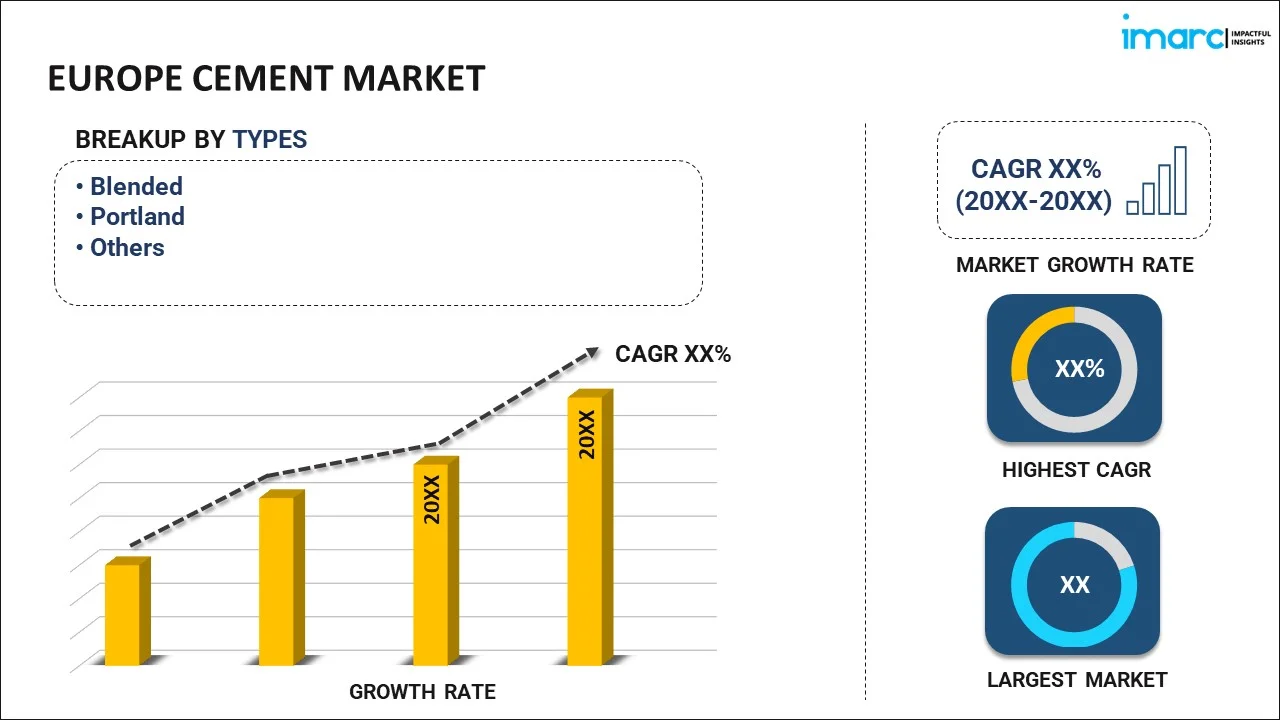
Europe Cement Market Report by Type (Blended, Portland, and Others), End Use (Residential, Commercial, Infrastructure), and Country 2025-2033
Market Overview:
The Europe cement market size reached 315.8 Million Tons in 2024. Looking forward, IMARC Group expects the market to reach 450.1 Million Tons by 2033, exhibiting a growth rate (CAGR) of 3.77% during 2025-2033.
|
Report Attribute
|
Key Statistics
|
|---|---|
|
Base Year
|
2024 |
|
Forecast Years
|
2025-2033
|
|
Historical Years
|
2019-2024
|
| Market Size in 2024 | 315.8 Million Tons |
| Market Forecast in 2033 | 450.1 Million Tons |
| Market Growth Rate (2025-2033) | 3.77% |
Cement, also known as Portland cement, is a grey-colored inorganic substance with excellent hydraulic binding ability. It is a mixture of finely ground minerals that results in a rock-like substance when mixed with sand, water and gravel. Cement is widely used to produce concrete, which is a crucial building material for mass constructions, such as industrial estates, dwellings and civil works. Nowadays, different types of cement are produced to meet additional physical and chemical requirements of specific situations, such as durability and strength.
Europe Cement Market Trends:
The Europe cement market is primarily driven by the revival of the real estate sector and the increasing demand for cement in the residential and commercial sectors. Besides this, the European Union (EU) is investing heavily to enhance the existing infrastructure, which is further projected to contribute to the market growth. Moreover, due to the growing concerns regarding the environmental impact of cement production, manufacturers are introducing new production methods and formulations that help reduce energy use and utilize locally available raw materials. Consequently, there has been an increase in the sales of sustainable and green cement as it minimizes CO2 emissions generated during production.
Key Market Segmentation:
IMARC Group provides an analysis of the key trends in each sub-segment of the Europe cement market report, along with forecasts at the regional and country level from 2025-2033. Our report has categorized the market based on type and end use.
Breakup by Type:

- Blended
- Portland
- Others
Breakup by End Use:
- Residential
- Commercial
- Infrastructure
Breakup by Country:
- Germany
- France
- United Kingdom
- Italy
- Spain
- Others
Competitive Landscape:
The competitive landscape of the industry has also been examined along with the profiles of the key players.
Report Coverage:
| Report Features | Details |
|---|---|
| Base Year of the Analysis | 2024 |
| Historical Period | 2019-2024 |
| Forecast Period | 2025-2033 |
| Units | Million Tons |
| Segment Coverage | Type, End Use, Country |
| Countries Covered | Germany, France, United Kingdom, Italy, Spain, Others |
| Customization Scope | 10% Free Customization |
| okPost-Sale Analyst Support | 10-12 Weeks |
| Delivery Format | PDF and Excel through Email (We can also provide the editable version of the report in PPT/Word format on special request) |
Key Questions Answered in This Report
The Europe cement market size was approximately 315.8 Million Tons in 2024. The elevating number of renovation, remodeling, and reconstruction projects is primarily driving the demand for cement in the region. Additionally, the widespread adoption of cement in the construction of bridges, dams, high-rise structures, residential and industrial complexes, etc., is further propelling the European cement market. Moreover, the introduction of green cement to construct eco-friendly and sustainable buildings that will aid in reducing harmful emissions and supporting environmental health will continue to augment the market growth in the coming years.
We expect the Europe cement market to exhibit a CAGR of 3.77% during 2025-2033.
The rising number of construction activities pertaining to the development of mega infrastructure projects, along with the elevating levels of urbanization, is primarily driving the Europe cement market.
The sudden outbreak of the COVID-19 pandemic had led to the implementation of stringent lockdown regulations across several European nations, resulting in the temporary halt in numerous construction activities, thereby negatively impacting the Europe market for cement.
Based on the end use, the Europe cement market can be bifurcated into residential, commercial, and infrastructure. Currently, the residential sector exhibits a clear dominance in the market.
On a regional level, the market has been classified into Germany, France, United Kingdom, Italy, Spain, and others, where Germany currently dominates the Europe cement market.
Need more help?
- Speak to our experienced analysts for insights on the current market scenarios.
- Include additional segments and countries to customize the report as per your requirement.
- Gain an unparalleled competitive advantage in your domain by understanding how to utilize the report and positively impacting your operations and revenue.
- For further assistance, please connect with our analysts.
 Inquire Before Buying
Inquire Before Buying
 Speak to an Analyst
Speak to an Analyst
 Request Brochure
Request Brochure
 Request Customization
Request Customization




.webp)




.webp)












